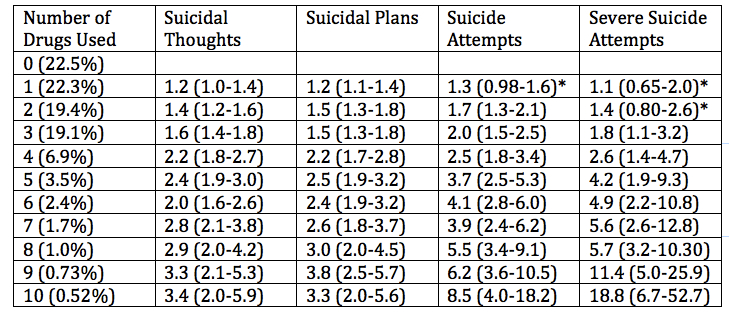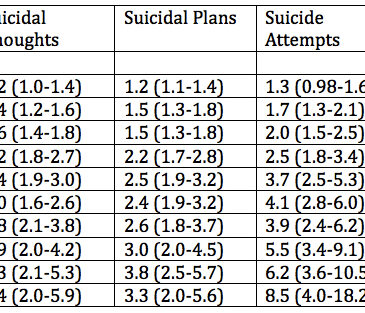This week, as part of National Drug Facts Week, the National Institute on Drug Abuse helps refute myths about drugs by providing science-based resources and promoting local events for teens. This week, in support of highlighting the science of youth drug use, STASH reviews a recent study that examined the relationships between youth drug use patterns and suicidal behavior (Wong, Zhou, Goebert, & Hishinuma, 2013).
Methods
- The authors analyzed data from 73,183 high school students who participated in the Youth Risk Behavior Survey (YRBS) between 2001 and 2009.
- The YRBS is a school-based survey that assesses a diversity of risk events, such as suicidal thoughts and behaviors, substance use, eating disorder, and interpersonal violence. The survey also records demographics and mental health problems.
- This STASH reports on findings that emerged from a set of multiple logistic regression analyses that examined lifetime drug and drug use patterns (i.e., involvement, or the total number of drugs used) for 10 drugs (i.e., heroin, methamphetamine, steroids, cocaine, inhalants, hallucinogen, ecstasy, alcohol, tobacco, and marijuana) and their association with the following four past-year suicide behaviors: suicide ideation; suicide plans; suicide attempts; and, severe suicide attempts requiring medical attention.
Results
- For all 10 assessed drugs, reports of lifetime use were associated with increased risk of the four suicide behaviors, even after controlling for 13 potential confounders.1
- Those who used heroin had the greatest risk (Odds ratios ranged from 1.9-4.3), whereas those who used marijuana and tobacco had the lowest risk–but still higher than those who used no drugs (Odds ratios ranged from 1.4-1.8 and 1.3-1.9, respectively).
- Involvement analyses suggested that using more substances increased the risk for suicide ideation, suicide plans, suicide attempts, and severe suicide attempts requiring medical attention (See Table 1). For example, students who used 1 substance were twice as likely than those who used no substances to report a past-year suicide attempt. Those who used 6 substances were 4 times more likely to report past-year suicide attempts.

Figure. Lifetime Drug Use Involvement (i.e., number of drugs used) and Past Year Risk for Suicidal Behavior. Note. Odds ratios are in comparison with no lifetime use of any drugs. All odds ratios listed above were statistically significant unless indicated with *. In the first column, numbers in parentheses indicate the percent of respondents in each category. For instance, 22.5% of respondents indicate no lifetime use of any drugs. Adapted from Wong et al. (2013). Click image to enlarge.
Limitations
- The study relied on self-reported risk behaviors, which can be limited by memory, self-presentation biases, and reporting biases.
- The study assessed lifetime drug use behavior, and therefore proximal (e.g., past year) associations with suicidal behaviors remain unknown.
- The study design is not longitudinal, so the analyses cannot assess the causal nature of the relationships between drug use and suicidal behaviors. For example, suicidal behavior might increase the risk for substance use.
Conclusion
This research suggests that specific drugs and drug use patterns are strong predictors of diverse suicide behavior outcomes. Notably, youths’ “involvement” with greater numbers of drugs is a powerful predictor of suicidal ideation, suicidal plans, suicide attempts, and severe suicide attempts. These findings are similar to involvement effects apparent in other expressions of addiction. For example, the diversity of gambling types with which an individual engages is associated with one’s risk for having Gambling Disorder (LaPlante, Nelson, & Gray, 2013). This youth drug use research suggests that in addition to examining youths’ specific drug use behavior for clues about suicide risk, it is important to consider overall drug use behavior patterns to identify the youths who are at greatest risk for suicidal behaviors.
– Debi LaPlante (@DebiLaPlante)
What do you think? Please use the comment link below to provide feedback on this article.
References
LaPlante, D. A., Nelson, S. E., & Gray, H. M. (2013). Breadth and depth involvement: Understanding Internet gambling involvement and its relationship to gambling problems. Psychology of Addictive Behaviors, Online First. doi: 10.1037/a0033810
Wong, S. S., Zhou, B., Goebert, D., & Hishihuma, E. S. (2013). The risk of adolescent suicide across patterns of drug use: A nationally representative study of high school students in the United States from 1999-2009. Social Psychiatry and Psychiatric Epidemiology, 48, 1611-1620.
________________
[1] The authors reported that potential confounders included the following variables: age, gender, ethnicity, grade, partner violence, forced sexual intercourse, physical fights, school violence, unsafe feelings, depressive symptoms, restrictive symptoms and purging symptoms of eating disorders, and sexual intercourse.




